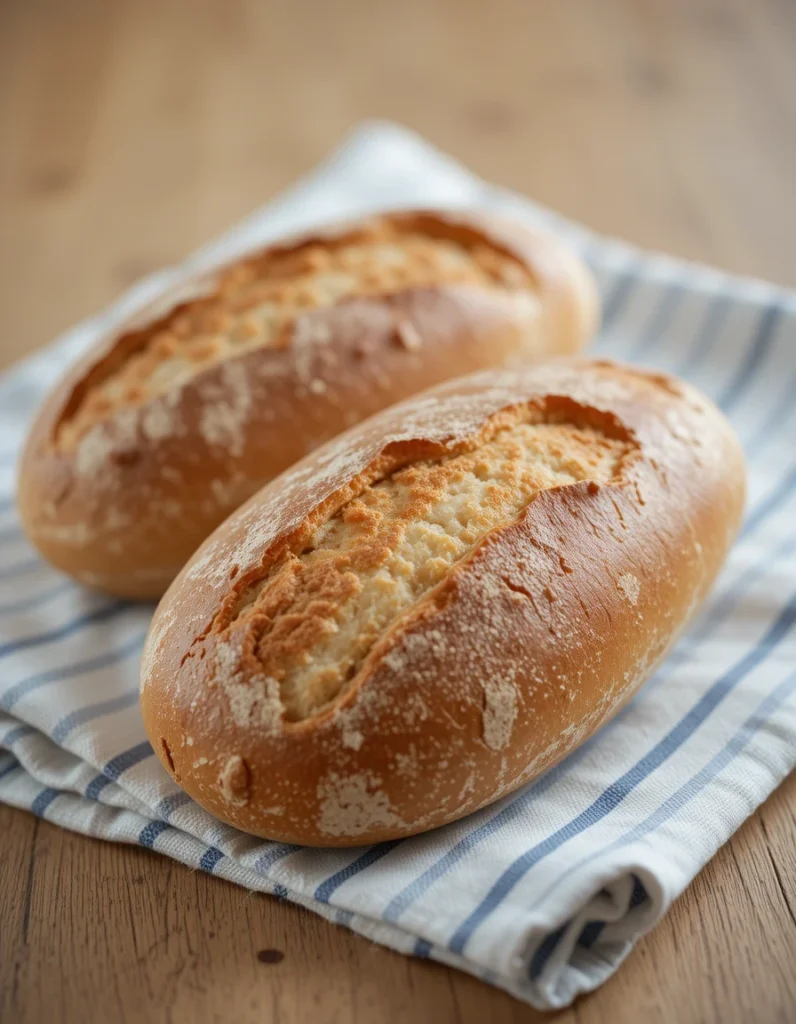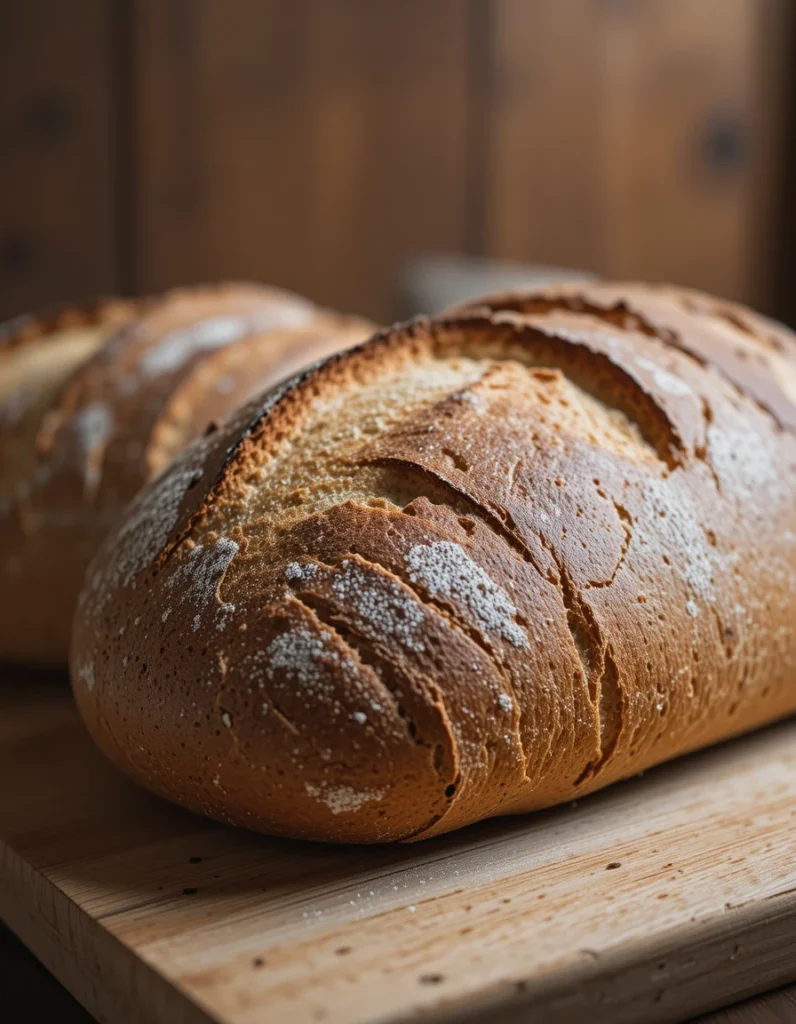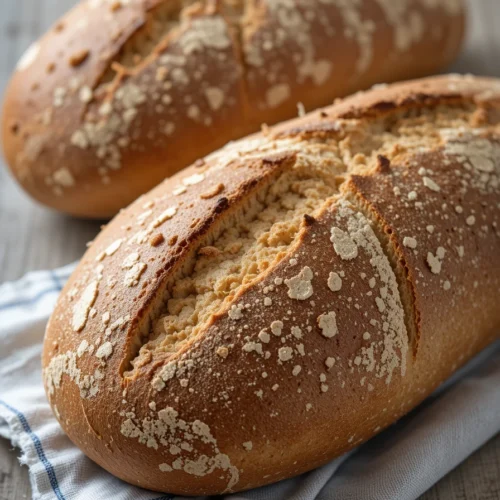Introduction to Batard Bread
What is Batard Bread?
Batard bread, often compared to its more famous sibling, the baguette, is a traditional French bread with a somewhat rounder shape and a soft, chewy texture. The name “batard” comes from the French term for “bastard,” a nod to its position as a bread that’s somewhere between the baguette and a boule. Unlike the long, slender baguette, batard bread has a slightly shorter and thicker form, making it more versatile for a variety of culinary uses. Its delicate crumb and crispy crust make it a favorite for everything from sandwiches to dipping in soups or oils. But despite its deliciousness, it often doesn’t receive the same fame as the baguette, though it certainly deserves its time in the spotlight.
Table of Contents
Origin and History of Batard Bread
The origins of batard bread are deeply rooted in French baking traditions. Like many other French breads, it developed as bakers sought to create a bread that would be perfect for everyday meals. While the baguette has become the quintessential symbol of French bread culture, the batard has a slightly less well-known but equally important place in the bread-baking world.
It was likely born from the desire for a bread that was easier to bake in smaller ovens, making it more accessible to local bakers in rural areas. Over time, batard bread became a staple across France and eventually found its way into other parts of the world. It is often considered the “everyday bread,” loved for its balance of crunchy crust and soft, airy interior. Unlike many other French breads, batard bread can be found in various regional varieties across France, each adding a unique touch to the classic recipe.

The Art of Making Batard Bread
Key Ingredients for Batard Bread
To create a perfect batard bread, you need the right balance of ingredients. The basics are simple, yet the outcome can be extraordinary. Here’s what you’ll need:
- Flour: Bread flour is essential for its high gluten content, which helps to create a chewy texture and a strong structure for the bread. Some bakers may mix it with a small amount of whole wheat flour for added flavor.
- Water: The water should be lukewarm to activate the yeast. The right amount of water will make the dough smooth and elastic.
- Salt: Salt is vital for enhancing the flavor and regulating yeast activity. It also helps to strengthen the dough.
- Yeast: Traditional bakers use active dry yeast or instant yeast to leaven the bread. Some opt for a natural sourdough starter, which can add complexity and a tangy flavor to the bread.
- Olive oil (optional): Some recipes include a small amount of olive oil to add richness and flavor to the bread.
These ingredients, though few, come together to form the foundation of an amazing batard bread.
Step-by-Step Batard Bread Recipe
- Prepare the Dough: Start by mixing the flour, yeast, and salt in a large bowl. Gradually add the lukewarm water, stirring with a wooden spoon until the dough begins to come together.
- Knead the Dough: Turn the dough out onto a floured surface and knead for about 8-10 minutes, until smooth and elastic. If the dough feels too sticky, you can add a little more flour, but be careful not to overdo it.
- Let the Dough Rise: Place the dough in a lightly oiled bowl, cover with a damp cloth, and let it rise for about an hour, or until it has doubled in size.
- Shape the Dough: Once the dough has risen, punch it down to release air bubbles and shape it into a batard. Roll it into a thick log, about 12 inches long, and taper the ends slightly.
- Second Rise: Place the shaped dough onto a baking sheet lined with parchment paper. Cover and let it rise again for about 30 minutes.
- Bake the Batard: Preheat your oven to 450°F (230°C). Before baking, make a few shallow slashes across the top of the bread with a sharp knife to help it expand while baking. Bake for 20-25 minutes, or until the crust is golden brown and crispy.
Tips for Perfect Batard Bread Texture and Crust
- Use a baking stone: If possible, bake your batard bread on a preheated baking stone. This helps to maintain a consistent heat and gives the bread a professional-level texture.
- Steam your oven: To achieve that perfect, crispy crust, you can create steam in the oven by placing a pan of water at the bottom of the oven or spraying the bread with water before baking.
- Don’t rush the rise: Allowing the dough to rise fully is crucial for achieving the airy texture that batard bread is known for. Patience here is key.

Batard Bread vs. Baguette: What’s the Difference?
Size and Shape Differences
When comparing batard bread to a baguette, the most obvious difference lies in their shape. While the baguette is long and thin, typically about 2-3 feet in length, the batard bread is shorter and thicker, usually around 12 inches. This results in a more substantial, hearty loaf that is easier to slice for sandwiches or serving with meals.
Texture and Crust Differences
The texture of batard bread is denser than a baguette, giving it a chewier crumb. This makes it a great choice for heartier sandwiches or as an accompaniment to stews and soups. In terms of crust, the batard bread has a thicker, crunchier exterior compared to the baguette, which has a slightly softer crust. The difference in texture comes from the way each bread is shaped and baked, with batards typically requiring a longer proofing time.
Taste and Flavor Differences
While both loaves have a delicious, yeasty flavor, batard bread has a more rustic taste, partly due to its thicker crumb and longer rise time. The baguette, on the other hand, is often lighter and more delicate in flavor. The thicker, richer texture of batard bread gives it more of a bready taste, making it perfect for dipping or enjoying with a variety of spreads.
Sourdough Batard: A Unique Twist on Traditional Batard Bread
What Makes Sourdough Batard Different?
Sourdough batard bread takes the classic recipe and infuses it with a tangy twist, thanks to the natural fermentation process. Instead of using store-bought yeast, sourdough batard relies on a starter made from wild yeast and lactic acid bacteria, which contributes a more complex flavor. The resulting bread has a more pronounced sourness and a slightly denser texture, which many people find more flavorful and satisfying.
Health Benefits of Sourdough Batard Bread
There are several health benefits to choosing sourdough batard bread over regular batard bread. The wild fermentation process breaks down some of the gluten in the flour, which can make sourdough easier to digest for those with mild gluten sensitivities. Moreover, the bacteria in the sourdough starter produce beneficial compounds, such as lactic acid, which may support gut health and help regulate blood sugar levels.
How to Make Sourdough Batard Bread
Making sourdough batard bread follows much of the same process as traditional batard, with the key difference being the use of a sourdough starter. You’ll need to start by feeding your sourdough starter for several days before using it. Once your starter is active, simply replace the yeast in your traditional recipe with your starter, and follow the same steps for mixing, kneading, rising, and baking.

Health Benefits of Batard Bread
Is Batard Bread Healthy?
Batard bread, like many other breads, can be part of a healthy diet when consumed in moderation. It provides essential carbohydrates, which are the body’s primary source of energy. Additionally, batard bread is often made with fewer additives compared to store-bought varieties, making it a more natural option.
Nutritional Value of Batard Bread
While batard bread may not be a superfood, it does have some nutritional value. One slice of batard bread typically contains around 70-100 calories, depending on its size. It also provides small amounts of protein, fiber, and essential minerals like iron. To make it even healthier, some people opt to add whole grains to their batard recipe.
How Batard Bread Supports Gut Health
The process of making batard bread involves fermentation, which helps break down some of the carbohydrates in the flour. This can make batard bread easier to digest and can promote a healthy gut microbiome, as beneficial bacteria are involved in the fermentation process. Moreover, the presence of fiber helps to regulate digestion.
Is Batard Bread Good for People with High Blood Pressure?
When consumed as part of a balanced diet, batard bread can be a good option for people with high blood pressure, especially when it’s made with whole grains. Whole grain breads are known to support heart health due to their high fiber content, which helps regulate blood pressure and reduce cholesterol levels. However, it is important to consume batard bread in moderation, as it can be high in sodium, especially if you add salt during the baking process.

Batard Bread in Different Cultures
Batard Bread in France and Beyond
In France, batard bread is a beloved staple. While the baguette may be the country’s most iconic bread, the batard is equally cherished, particularly in rural areas. Many French bakeries offer it alongside other classic breads. It is often served as an accompaniment to family meals or used in sandwiches, with its sturdy texture making it ideal for filling.
How Different Cultures Enjoy Batard Bread
Across the world, batard bread has found its place in various culinary traditions. In the United States, for example, it is often used for hearty sandwiches or served with soups. In Italy, it might be paired with rich olive oils and vinegars, or even grilled as part of antipasti platters.
Common Questions About Batard Bread (FAQs)
What is Hillbilly Bread?
Hillbilly bread is often a regional name for a rustic, homemade bread that is similar to batard bread but tends to have a denser texture and simpler ingredients. It is usually made with basic ingredients like flour, water, yeast, and salt.
What is the Most Popular Bread in Switzerland?
In Switzerland, the most popular type of bread is Zopf, a braided bread that is slightly sweet and soft. Although batard bread is not as widely consumed, it is still appreciated in Swiss culinary traditions.
What is the Healthiest Bread to Eat in the World?
Whole grain breads, like whole wheat batard bread, are considered some of the healthiest options. They provide more fiber and essential nutrients compared to white bread, making them a better choice for overall health.
What Kind of Bread is Good for High Blood Pressure?
Whole grain bread, including batard bread, is a good choice for people with high blood pressure. The fiber in whole grains helps to lower cholesterol and manage blood pressure.

Sourdough Batard
Equipment
- 1 Kitchen Scale For accurate measurements
- 1 Food Thermometer For checking water temperature (80F/27C)
- 1 Clean, Clear Jar Large enough for levain to double in volume
- 1 Large Mixing Bowl For mixing the dough
- 1 Straight Container Optional, but helpful for measuring dough rise
- 1 Lidded Loaf Pan Can use other styles or a sheet pan if preferred
- 1 Parchment Paper For lining the loaf pan
Ingredients
- 25 g grams Active Sourdough Starter
- 50 g grams Flour Any flour combination all-purpose or bread flour
- 50 g grams Filtered Water 80F/27C for levain and dough
- 100 g grams Levain active starter
- 375 g grams Filtered Water 80F/27C for dough
- 500 g grams Bread Flour Plus more for shaping
- 10-12 g grams Salt sea salt ideal
Instructions
- Make the Levain:
- Combine 25g active starter, 50g water (80F/27C), and 50g flour. Mix well until no lumps remain. Cover and let rise for 8-12 hours until bubbly and doubled.
- Make the Bread:
- Add 100g levain to a mixing bowl. Add 375g filtered water and mix. Add salt, then flour. Mix until fully combined into a shaggy dough. Rest for 30 minutes.
- Stretch and Fold:
- After resting, perform 4-5 sets of stretch and folds at 30-minute intervals. The dough should be smooth, elastic, and pass the translucency test.
- Bulk Fermentation:
- Allow dough to rise 50% in volume in a warm spot (under 90F/32C). You can refrigerate to slow it down if needed.
- Pre-shape and Shape:
- Gently pre-shape dough and let rest for 20 minutes. Then shape it by folding lengthwise, creating tension on the top. Place in a banneton.
- Final Proof:
- Refrigerate dough for 8-36 hours.
- Bake:
- Preheat oven to 450F/235C with a baking vessel inside. Transfer dough to the preheated vessel, cover, and bake for 30 minutes. Remove lid and reduce temperature to 400F/205C, continuing to bake for 15-20 minutes until golden.
- Cool:
- Remove from the oven, and let cool for at least 1 hour before slicing.
Notes
- evain can be used when bubbles break the surface, or when it has risen and passes the float test.
- The exact timing for fermentation will depend on ambient temperature and starter activity.
Conclusion: Why Batard Bread is a Must-Try
Batard Bread’s Versatility and Flavor
In conclusion, batard bread is a delicious and versatile bread that deserves a spot in any kitchen. Its rich, chewy texture and crispy crust make it perfect for a variety of dishes. Whether you enjoy it as a sandwich or alongside a hearty stew, batard bread offers both flavor and substance. It’s a bread that represents the best of French baking traditions, and its health benefits make it a smart choice for any diet. So, give it a try – you might just find your new favorite bread!
Check out our latest article for more insights, and follow us on Facebook for updates! and connect with us on Pinterest and YouTube for more inspiration
By: Sofia




